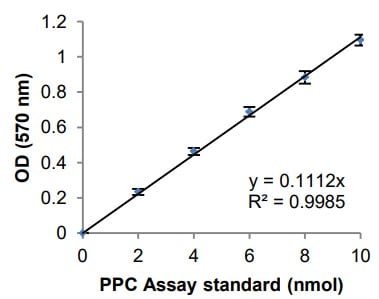Phosphoenolpyruvate Carboxylase Assay Kit (Colorimetric) (ab239720)
Key features and details
- Detection method: Colorimetric
- Platform: Microplate reader
- Sample type: Adherent cells, Suspension cells
Overview
-
Product name
Phosphoenolpyruvate Carboxylase Assay Kit (Colorimetric) -
Detection method
Colorimetric -
Sample type
Adherent cells, Suspension cells -
Product overview
Phosphoenolpyruvate carboxylase (PPC) is an enzyme found in plants and some types of bacteria that catalyzes the formation of oxaloacetate from phosphoenolpyruvate (PEP) by fixing one carbon in the forms of either carbon dioxide or bicarbonate. PPC participates in carbon fixation in C4 photosynthesis and Crassulacean acid metabolism (CAM) in plants and acts as an anaplerotic enzyme, which replenishes TCA cycle intermediates, in bacteria and C3 plants. The participation of PPC in the carbon fixation cycle of C4 plants enable them to survive in high sunlight but dry environments.
Phosphoenolpyruvate Carboxylase Assay Kit (Colorimetric) (ab239720) provides a quick and easy method for the measurement of PPC activity in various samples. In this assay, PPC is coupled with a set of enzymes that convert PEP and carbonate into a series of intermediates and hydrogen peroxide, which in turn, reacts with a probe and converter generating a colorimetric signal (OD 570 nm). The generated absorbance signal is directly proportional to the amount of active PPC present in the samples. This kit provides a simple, fast and high throughput adaptable assay to measure the activities of PPC as low as 0.2 Mu.
-
Platform
Microplate reader
Properties
-
Storage instructions
Store at -20°C. Please refer to protocols. -
Components 100 tests PPC Assay Buffer 1 x 25ml PPC Enzyme Mix 1 vial PPC Positive Control 1 vial PPC Probe (in DMSO) 1 x 220µl PPC Standard (100 mM) 1 x 100µl PPC Substrate A 1 vial PPC Substrate B 1 x 220µl -
Research areas
-
Relevance
Major sites of expression of PEP Carboxylase are liver, kidney and adipocytes. PEP carboxylase, along with GTP, catalyzes the formation of phosphoenolpyruvate from oxaloacetate, with the release of carbon dioxide and GDP. The expression of this gene can be regulated by insulin, glucocorticoids, glucagon, cAMP, and diet. A mitochondrial isozyme of the encoded protein has also been characterized. -
Cellular localization
Cytoplasmic -
Alternative names
- PEPC 1
- PEPCase 1
- Phosphoenolpyruvate carboxylase 1










